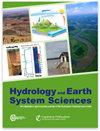Seasonal soil moisture and crop yield prediction with fifth-generation seasonal forecasting system (SEAS5) long-range meteorological forecasts in a land surface modelling approach
IF 5.8
1区 地球科学
Q1 GEOSCIENCES, MULTIDISCIPLINARY
引用次数: 0
Abstract
Abstract. Long-range weather forecasts provide predictions of atmospheric, ocean and land surface conditions that can potentially be used in land surface and hydrological models to predict the water and energy status of the land surface or in crop growth models to predict yield for water resources or agricultural planning. However, the coarse spatial and temporal resolutions of available forecast products have hindered their widespread use in such modelling applications, which usually require high-resolution input data. In this study, we applied sub-seasonal (up to 4 months) and seasonal (7 months) weather forecasts from the latest European Centre for Medium-Range Weather Forecasts (ECMWF) seasonal forecasting system (SEAS5) in a land surface modelling approach using the Community Land Model version 5.0 (CLM5). Simulations were conducted for 2017–2020 forced with sub-seasonal and seasonal weather forecasts over two different domains with contrasting climate and cropping conditions: the German state of North Rhine-Westphalia (DE-NRW) and the Australian state of Victoria (AUS-VIC). We found that, after pre-processing of the forecast products (i.e. temporal downscaling of precipitation and incoming short-wave radiation), the simulations forced with seasonal and sub-seasonal forecasts were able to provide a model output that was very close to the reference simulation results forced by reanalysis data (the mean annual crop yield showed maximum differences of 0.28 and 0.36 t ha−1 for AUS-VIC and DE-NRW respectively). Differences between seasonal and sub-seasonal experiments were insignificant. The forecast experiments were able to satisfactorily capture recorded inter-annual variations of crop yield. In addition, they also reproduced the generally higher inter-annual differences in crop yield across the AUS-VIC domain (approximately 50 % inter-annual differences in recorded yields and up to 17 % inter-annual differences in simulated yields) compared to the DE-NRW domain (approximately 15 % inter-annual differences in recorded yields and up to 5 % in simulated yields). The high- and low-yield seasons (2020 and 2018) among the 4 simulated years were clearly reproduced in the forecast simulation results. Furthermore, sub-seasonal and seasonal simulations reflected the early harvest in the drought year of 2018 in the DE-NRW domain. However, simulated inter-annual yield variability was lower in all simulations compared to the official statistics. While general soil moisture trends, such as the European drought in 2018, were captured by the seasonal experiments, we found systematic overestimations and underestimations in both the forecast and reference simulations compared to the Soil Moisture Active Passive Level-3 soil moisture product (SMAP L3) and the Soil Moisture Climate Change Initiative Combined dataset from the European Space Agency (ESA CCI). These observed biases of soil moisture and the low inter-annual differences in simulated crop yield indicate the need to improve the representation of these variables in CLM5 to increase the model sensitivity to drought stress and other crop stressors.利用第五代季节预报系统(SEAS5)的陆地模拟方法进行季节性土壤水分和作物产量预测
摘要长期天气预报提供对大气、海洋和陆地表面状况的预测,可用于陆地表面和水文模型,以预测陆地表面的水和能源状况,或用于作物生长模型,以预测水资源或农业规划的产量。然而,现有预报产品的粗糙时空分辨率阻碍了它们在这类建模应用中的广泛使用,这通常需要高分辨率的输入数据。在这项研究中,我们应用了来自最新的欧洲中期天气预报中心(ECMWF)季节预报系统(SEAS5)的分季节(长达4个月)和季节(7个月)天气预报,并使用社区土地模型5.0版本(CLM5)进行陆地表面建模方法。在德国北莱茵-威斯特伐利亚州(DE-NRW)和澳大利亚维多利亚州(us - vic)这两个气候和种植条件截然不同的不同区域,利用分季节和季节性天气预报对2017-2020年进行了模拟。我们发现,在对预报产品(即降水和入射短波辐射的时间尺度降尺度)进行预处理后,季节性和次季节性预报强迫的模拟结果能够提供与再分析数据强迫的参考模拟结果非常接近的模型输出(au - vic和DE-NRW的年平均作物产量差异最大,分别为0.28和0.36 tha - 1)。季节和次季节试验差异不显著。预测试验能够令人满意地捕捉到作物产量的年际变化。此外,他们还再现了与DE-NRW区域(记录产量的年际差异约为50%,模拟产量的年际差异高达17%)相比,AUS-VIC区域作物产量的年际差异普遍较高(记录产量的年际差异约为15%,模拟产量的年际差异高达5%)。预测模拟结果清晰再现了4个模拟年份中的高、低产季(2020年和2018年)。此外,分季节和季节模拟反映了2018年干旱年DE-NRW域的早期收获。然而,与官方统计数据相比,所有模拟的年际产量变异性都较低。虽然季节性实验捕获了一般的土壤湿度趋势,如2018年的欧洲干旱,但我们发现,与欧洲航天局(ESA CCI)的土壤湿度主动式被动3级土壤湿度产品(SMAP L3)和土壤湿度气候变化倡议组合数据集相比,预测和参考模拟都有系统的高估和低估。这些观测到的土壤湿度偏差和模拟作物产量年际差异较小表明需要改进CLM5中这些变量的表现,以提高模型对干旱胁迫和其他作物胁迫源的敏感性。
本文章由计算机程序翻译,如有差异,请以英文原文为准。
求助全文
约1分钟内获得全文
求助全文
来源期刊

Hydrology and Earth System Sciences
地学-地球科学综合
CiteScore
10.10
自引率
7.90%
发文量
273
审稿时长
15 months
期刊介绍:
Hydrology and Earth System Sciences (HESS) is a not-for-profit international two-stage open-access journal for the publication of original research in hydrology. HESS encourages and supports fundamental and applied research that advances the understanding of hydrological systems, their role in providing water for ecosystems and society, and the role of the water cycle in the functioning of the Earth system. A multi-disciplinary approach is encouraged that broadens the hydrological perspective and the advancement of hydrological science through integration with other cognate sciences and cross-fertilization across disciplinary boundaries.
 求助内容:
求助内容: 应助结果提醒方式:
应助结果提醒方式:


